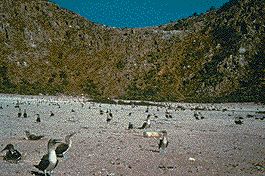Quantitative genetics - What has driven the evolution of beak sizes in Darwin's finches?

A long, dry season
In the Galapagos, the normal pattern of seasons is for a hot, wet season from about January to May to be followed by a cooler, dryer season through the rest of the year. But in early 1977, for some reason, the rain did not fall. The finch population of the island of Daphne Major collapsed from about 1200 to about 180 individuals, with smaller birds dying at a higher rate. The reason, again, lies in the food supply. A picture of the Daphne at this time is shown opposite.
At the beginning of the drought, the various types of seeds were present in their normal proportions. G. fortis of all sizes take small seeds, and as the drought persisted, these smaller seeds were relatively reduced in numbers; average available seed size became larger with time. Now the larger finches were favored, because they eat the larger, harder seeds more efficiently; and the average finch size increased as the smaller birds died off. Size in G. fortis is inherited. The differential mortality in the drought therefore caused an increase in the average size of finches born in the next generation. G. fortis born in 1978 were about 4% larger on average than those born before the drought.
| Next |



